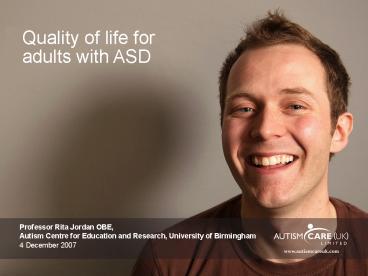Professor Rita Jordan OBE, - PowerPoint PPT Presentation
1 / 27
Title:
Professor Rita Jordan OBE,
Description:
Music and art may be a strength. Nature and awe. Need for physical exercise ... flow charts for challenging behaviour. positive experience of alternatives. ... – PowerPoint PPT presentation
Number of Views:68
Avg rating:5.0/5.0
Title: Professor Rita Jordan OBE,
1
Quality of life for adults with ASD
Professor Rita Jordan OBE, Autism Centre for
Education and Research, University of
Birmingham 4 December 2007
2
Learning style
- Visual rather than verbal
- Memory
- cued
- rote
- Social, a dimension of difficulty
- Emotions and cognition
- use interests for engagement
- At sensory stage of meaning
- presentation reference
- Repetition and consolidation
- Explicit strategies for problem solving.
3
Education and adults with ASD
- Continued entitlement to education for
- vocational skills
- leisure and occupation
- personal development
- Education as part of care and support
- facilitated and dignified
- Education as therapy
- social
- emotional
- communication
- flexibility training
- anxiety reduction.
4
Ecological curriculum
- Assess individual
- Assess current and future environments and
occupations - Gap in
- skills
- appreciation
- knowledge
- experience forms curriculum goals
- Teach in functional ways
- Practise in functional contexts.
5
Leisure support
- Need real-life experiences
- time to get used to it
- Extend obsessional interests
- Context for social skills
- Enriches life
- Informed choices
- Use of ICT.
6
Living support
- Education needs to engage with support and
self-advocate - Separate communities is not favoured
- how to ensure necessary flexibility?
- Graded support within the community
- specialist segregated community
- learning disabled community
- group homes and satellites
- supported houses and flats
- community support workers
- personal support schemes
- voluntary schemes.
7
Aesthetic and spiritual life
- Cultural participation
- Another dimension of experience
- Music and art may be a strength
- Nature and awe
- Need for physical exercise
- Schemes for appreciation
- activities in museums
- acting out pictures
- use of replication.
8
ICT
- Internet monitoring service
- Mobile phones
- independence
- communication
- Virtual and augmented reality
- more able to manage social situations when in
control - Enables work and friendships
- Serves interests.
9
Issues of personal involvement
- Reflection
- allow time
- include emotional context
- make pragmatically relevant
- Real and informed choices
- menus
- flow charts for challenging behaviour
- positive experience of alternatives.
10
Practical issues
- Opportunities for control of others/events
- with feedback
- External cueing of emotional states
- notice signs
- teach to person with ASD
- make relevant, i.e. lead to action
- Have fun.
11
Self-appraisal
- Build self comparisons
- chart progress on realistic goals
- Teach awareness of general problems for all, e.g.
agony aunt to assess understanding - Plan for failure as step in solution
- Draw attention to success
- Make mistakes explicit and reflect.
12
Process
- No fixed assumptions
- Enabling structures for participation (including
repetition) - Supporting the supporters paired schemes
- Allowing risk excitement
- Peers better than training.
13
Basic guide to anxiety reduction
- Awareness of initial build-up of anxiety
- as with emotional awareness outside in
- Positive attitude to coping (teach coping skills
and awareness) - drill for panic
- positive solution-focused problem solving
- Structure, e.g. lists
- preventative allows priorities and sense of
accomplishment - helps focus on positive actions.
14
Basic guide to anxiety reduction (continued)
- Relaxation
- general sensory/meditation/yoga/deep pressure
- specific fold arms, close eyes, chant or hum
- Exercise
- aerobic contingent and non-contingent
- Diets
- GI index low
- low stimulants
- sugar and additives
- Talking with others
- drawing
- music.
15
Cognitive behaviour therapy and ASD
- Growing use with ASD
- Hare
- Attwood
- Adapted materials for children with ASD
- Wood and Drahota, 2005 UCLA
- Traditional CBT relates well to traditional ASD
techniques.
16
Skills training
- Relaxation
- appropriate to situation
- general and specific
- Positive self-talk
- coach self through responses
- Self-reward
- supply or help identify positive consequences.
17
Teaching consequences
- Less able single track
- More able
- railway no turns
- two clear termini with no connections
- choice point emphasised.
18
Steven Degrieck purpose of a schedule
- To increase
- predictability
- independence
- flexibility
- quality of life.
19
Quality of life
- Depends on
- communicating at the right level of understanding
- introducing variety
- enabling toleration of changes
- introducing choices.
20
Poor quality of life
- Characterised by
- no influence on decisions affecting your life
- no changes. Rigidity, so no development over time
- no opportunity to increase skills and
understanding - no adaptation to you as an individual, including
- social
- cognitive
- sensory
- linguistic.
21
Choosing without understanding
22
Factors affecting choice in day-schedule
- Schedule is at wrong semantic level
- sensory presentation
representation symbolic - No experience of choice at mental level
- Teach semantics and choice
- Meanwhile, choose for them (enlightened
dictatorship).
23
Factors affecting choice in day-schedule
(continued)
24
Including choice
- Directly in the day schedule
- advantage options are immediately visible
- disadvantage options are limited
- With a reference system
- advantage options are not limited
- disadvantage options are not immediately
visible.
25
Including choice (continued)
26
Learning to choose
- Choosing is easier when options
- are communicated in a visual way
- are limited
- are known
- have different values (positive v negative)
- Remember, new always negative first.
27
Conclusion
- Final goal is always quality of life
- satisfying occupation
- self-esteem
- understanding
- informed choices
- positive experiences
- education
- All must be individualised quality of life is
often different for those with ASD.































